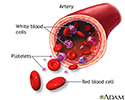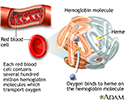Anemia caused by low iron - children
Anemia - iron deficiency - children
Anemia is a condition in which the body does not have enough healthy red blood cells. Red blood cells provide oxygen to body tissues. There are many types of anemia. Iron helps make red blood cells, so a lack of iron in the body may lead to anemia. The medical name of this problem is iron deficiency anemia.
Causes
Anemia caused by a low iron level is the most common form of anemia . The body gets iron through certain foods. It also reuses iron from old red blood cells.
Anemia
Anemia is a condition in which the body does not have enough healthy red blood cells. Red blood cells provide oxygen to body tissues. Different type...

A diet that does not have enough iron is the most common cause of this type of anemia in children. When a child is growing rapidly, such as during puberty, even more iron is needed.
Toddlers who drink too much cow's milk may also become anemic if they are not eating other healthy foods that have iron.
Other causes may be:
- The body is not able to absorb iron well, even though the child is eating enough iron
- Slow blood loss over a long period, often due to menstrual periods or bleeding in the digestive tract
Iron deficiency in children can also be related to lead poisoning .
Lead poisoning
Lead is a very strong poison. When a person swallows a lead object or breathes in lead dust, some of the poison can stay in the body and cause serio...
Symptoms
Mild anemia may have no symptoms. As the iron level and blood counts become lower, your child may:
- Act irritable
-
Become
short of breath
Short of breath
Breathing difficulty may involve:Difficult breathingUncomfortable breathingFeeling like you are not getting enough air
 ImageRead Article Now Book Mark Article
ImageRead Article Now Book Mark Article -
Crave unusual foods
Crave unusual foods
Pica is a pattern of eating non-food materials, such as dirt or paper.
Read Article Now Book Mark Article -
Eat less food
Eat less food
A decreased appetite is when your desire to eat is reduced. The medical term for a loss of appetite is anorexia.
Read Article Now Book Mark Article -
Feel tired
or
weak
all the time
Feel tired
Fatigue is a feeling of weariness, tiredness, or lack of energy.
Read Article Now Book Mark Article - Have a sore tongue
-
Have
headaches
or dizziness
Headaches
A headache is pain or discomfort in the head, scalp, or neck. Serious causes of headaches are rare. Most people with headaches can feel much better...
 ImageRead Article Now Book Mark Article
ImageRead Article Now Book Mark Article
With more severe anemia, your child may have:
- Blue-tinged or very pale whites of eyes
-
Brittle nails
Brittle nails
Nail abnormalities are problems with the color, shape, texture, or thickness of the fingernails or toenails.
 ImageRead Article Now Book Mark Article
ImageRead Article Now Book Mark Article -
Pale skin
Pale skin
Paleness is an abnormal loss of color from normal skin or mucous membranes.
 ImageRead Article Now Book Mark Article
ImageRead Article Now Book Mark Article
Exams and Tests
The health care provider will perform a physical exam.
Blood tests that measure iron level in the body include:
-
Hematocrit
Hematocrit
Hematocrit is a blood test that measures how much of a person's blood is made up of red blood cells. This measurement depends on the number of and s...
 ImageRead Article Now Book Mark Article
ImageRead Article Now Book Mark Article -
Serum ferritin
Serum ferritin
The ferritin blood test measures the level of ferritin in the blood. Ferritin is a protein inside your cells that stores iron. It allows your body ...
 ImageRead Article Now Book Mark Article
ImageRead Article Now Book Mark Article -
Serum iron
Serum iron
A serum iron test measures how much iron is in your blood.
 ImageRead Article Now Book Mark Article
ImageRead Article Now Book Mark Article -
Total iron binding capacity
(TIBC)
Total iron binding capacity
Total iron binding capacity (TIBC) is a blood test to see if you have too much or too little iron in your blood. Iron moves through the blood attach...
 ImageRead Article Now Book Mark Article
ImageRead Article Now Book Mark Article
A measurement called iron saturation (serum iron/TIBC) often can show whether the child has enough iron in the body.
Treatment
Since children only absorb a small amount of the iron they eat, most children need to have 8 to 10 mg of iron per day.
Eating healthy foods is the most important way to prevent and treat iron deficiency. Good sources of iron include:
- Apricots
- Chicken, turkey, fish, and other meats
- Dried beans, lentils, and soybeans
- Eggs
- Liver
- Molasses
- Oatmeal
- Peanut butter
- Prune juice
- Raisins and prunes
- Spinach, kale and other greens
If a healthy diet does not prevent or treat your child's low iron level and anemia, the doctor will likely recommend iron supplements for your child. These are taken by mouth.
DO NOT give your child iron supplements or vitamins with iron without checking with your child's doctor. The doctor will prescribe the right kind of supplement for your child. If your child takes too much iron, it can cause poisoning.
Outlook (Prognosis)
With treatment, the outcome is likely to be good. In most cases, the blood counts will return to normal in 2 months. It is important that the doctor find the cause of your child's iron deficiency.
Possible Complications
Anemia caused by a low iron level can affect a child's ability to learn in school. A low iron level can cause decreased attention span, reduced alertness, and learning problems in children.
A low iron level can cause the body to absorb too much lead.
Prevention
Eating a variety of healthy foods is the most important way to prevent and treat iron deficiency.
References
Fleming MD. Disorders of iron and copper metabolism, the sideroblastic anemias, and lead toxicity. In: Orkin SH, Fisher DE, Ginsburg D, Look AT, Lux SE, Nathan DG, eds. Nathan and Oski's Hematology and Oncology of Infancy and Childhood . 6th ed. Philadelphia, PA: Elsevier Saunders; 2015:chap 11.
Sills R. Iron-deficiency anemia. In: Kliegman RM, Stanton BF, St Geme JW, Schor NF, eds. Nelson Textbook of Pediatrics . 20th ed. Philadelphia, PA: Elsevier; 2016:chap 455.
-
Red blood cells, target cells - illustration
These abnormal red blood cells (RBCs) resemble targets. These cells are seen in association with some forms of anemia, and following the removal of the spleen (splenectomy).
Red blood cells, target cells
illustration
-
Formed elements of blood - illustration
Blood transports oxygen and nutrients to body tissues and returns waste and carbon dioxide. Blood distributes nearly everything that is carried from one area in the body to another place within the body. For example, blood transports hormones from endocrine organs to their target organs and tissues. Blood helps maintain body temperature and normal pH levels in body tissues. The protective functions of blood include clot formation and the prevention of infection.
Formed elements of blood
illustration
-
Hemoglobin - illustration
Hemoglobin is the most important component of red blood cells. It is composed of a protein called heme, which binds oxygen. In the lungs, oxygen is exchanged for carbon dioxide. Abnormalities of an individual's hemoglobin value can indicate defects in the normal balance between red blood cell production and destruction. Both low and high values can indicate disease states.
Hemoglobin
illustration
-
Red blood cells, target cells - illustration
These abnormal red blood cells (RBCs) resemble targets. These cells are seen in association with some forms of anemia, and following the removal of the spleen (splenectomy).
Red blood cells, target cells
illustration
-
Formed elements of blood - illustration
Blood transports oxygen and nutrients to body tissues and returns waste and carbon dioxide. Blood distributes nearly everything that is carried from one area in the body to another place within the body. For example, blood transports hormones from endocrine organs to their target organs and tissues. Blood helps maintain body temperature and normal pH levels in body tissues. The protective functions of blood include clot formation and the prevention of infection.
Formed elements of blood
illustration
-
Hemoglobin - illustration
Hemoglobin is the most important component of red blood cells. It is composed of a protein called heme, which binds oxygen. In the lungs, oxygen is exchanged for carbon dioxide. Abnormalities of an individual's hemoglobin value can indicate defects in the normal balance between red blood cell production and destruction. Both low and high values can indicate disease states.
Hemoglobin
illustration
Review Date: 2/11/2016
Reviewed By: Todd Gersten, MD, Hematology/Oncology, Florida Cancer Specialists & Research Institute, Wellington, FL. Review provided by VeriMed Healthcare Network. Also reviewed by David Zieve, MD, MHA, Isla Ogilvie, PhD, and the A.D.A.M. Editorial team.



